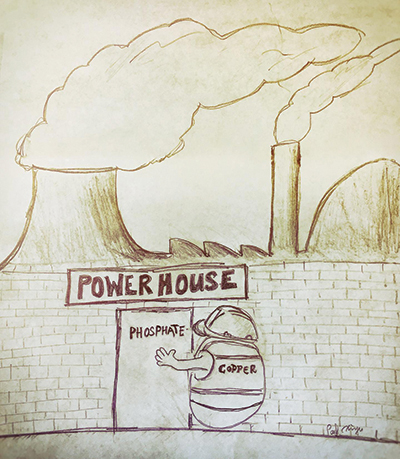JBC: Scientists fill in a piece of the copper transport puzzle
Researchers have identified the protein that carries copper into mitochondria, where copper is required for the functioning of the cell’s energy conversion machinery. The discovery, the Journal of Biological Chemistry, fills in a piece of the puzzle of how copper is distributed and used in the cell.
 Mitochondria, the powerhouses of the cell, need copper to produce energy. Copper enters the mitochondria through a previously identified phosphate transporter.Courtesy of Paul Cobine and Xinyu Zhu/Auburn University Humans acquire copper in trace amounts from food. Despite its low levels, copper is essential for the functioning of numerous important enzymes, such as some of those involved in synthesizing collagen and neurotransmitters. Notably, copper is required for building cytochrome c oxidase, known as COX, a large protein complex in mitochondria that forms the last step of the electron transport chain, which harvests energy for the production of ATP, the energy currency of the cell.
Mitochondria, the powerhouses of the cell, need copper to produce energy. Copper enters the mitochondria through a previously identified phosphate transporter.Courtesy of Paul Cobine and Xinyu Zhu/Auburn University Humans acquire copper in trace amounts from food. Despite its low levels, copper is essential for the functioning of numerous important enzymes, such as some of those involved in synthesizing collagen and neurotransmitters. Notably, copper is required for building cytochrome c oxidase, known as COX, a large protein complex in mitochondria that forms the last step of the electron transport chain, which harvests energy for the production of ATP, the energy currency of the cell.
of Auburn University and his collaborator at the University of Saskatchewan have been working for more than 10 years on understanding how copper is used to assemble COX. One basic question was, how does copper get across the membranes in mitochondria?
“To get (copper) to the correct address (in the cell) without interfering with other proteins, or disrupting other targets that have a high chance of binding copper, is a herculean delivery effort,” Cobine said. “This is akin to finding your way to an exit in a crowded bar without touching the other people or getting redirected. Then after finding the exit, you must make sure you go through the right door.”
The researchers used multiple lines of evidence to arrive at an answer: Copper is transported within mitochondria by a protein called SLC25A3. This discovery was surprising because SLC25A3 was already known to transport phosphate, a negatively charged ion, whereas copper ions carry a positive charge. The researchers speculate that the copper ions may need to bind to another partner, forming a negatively charged complex, for SLC25A3 to be able to transport it. The next question they want to address is how the transporter distinguishes between its different types of cargo.
Previously known mutations in the gene encoding SLC25A3 are responsible for poorly understood genetic disorders involving dysfunctional heart and muscle fibers, leading to enlarged hearts and low muscle tone. As these tissues require large amounts of energy, it seems plausible that these patients’ symptoms could be related to insufficient copper transport in mitochondria.
These symptoms “all sound like they could be related to both ATP production and cytochrome c oxidase,” Cobine said.
With the discovery of the copper transport pathway within mitochondria, the health effects of copper can be studied in more detail because researchers will be able to distinguish the effects of copper on COX from the other pathways it’s involved in.
“If we don’t deal with copper properly throughout our life, what are the metabolic diseases that come up?” Cobine asks. “Now we have the ability to look at what happens when you lose mitochondrial copper at different (developmental) stages.”
Enjoy reading ASBMB Today?
Become a member to receive the print edition four times a year and the digital edition weekly.
Learn moreGet the latest from ASBMB Today
Enter your email address, and weãll send you a weekly email with recent articles, interviews and more.
Latest in Science
Science highlights or most popular articles

Guiding grocery carts to shape healthy habits
Robert ãNateã Helsley will receive the Walter A. Shaw Young Investigator in Lipid Research Award at the 2025 ASBMB Annual Meeting, April 12ã15 in Chicago.

Quantifying how proteins in microbe and host interact
ãTo develop better vaccines, we need new methods and a better understanding of the antibody responses that develop in immune individuals,ã author Johan Malmström said.

Leading the charge for gender equity
Nicole Woitowich will receive the ASBMB Emerging Leadership Award at the 2025 ASBMB Annual meeting, April 12ã15 in Chicago.

CRISPR gene editing: Moving closer to home
With the first medical therapy approved, thereãs a lot going on in the genome editing field, including the discovery of CRISPR-like DNA-snippers called Fanzors in an odd menagerie of eukaryotic critters.

Finding a missing piece for neurodegenerative disease research
Ursula Jakob and a team at the University of Michigan have found that the molecule polyphosphate could be what scientists call the ãmystery densityã inside fibrils associated with Alzheimerãs, Parkinsonãs and related conditions.

From the journals: JLR
Enzymes as a therapeutic target for liver disease. Role of AMPK in chronic liver disease Zebrafish as a model for retinal dysfunction. Read about the recent JLR papers on these topics.

.jpg?lang=en-US&width=300&height=300&ext=.jpg)